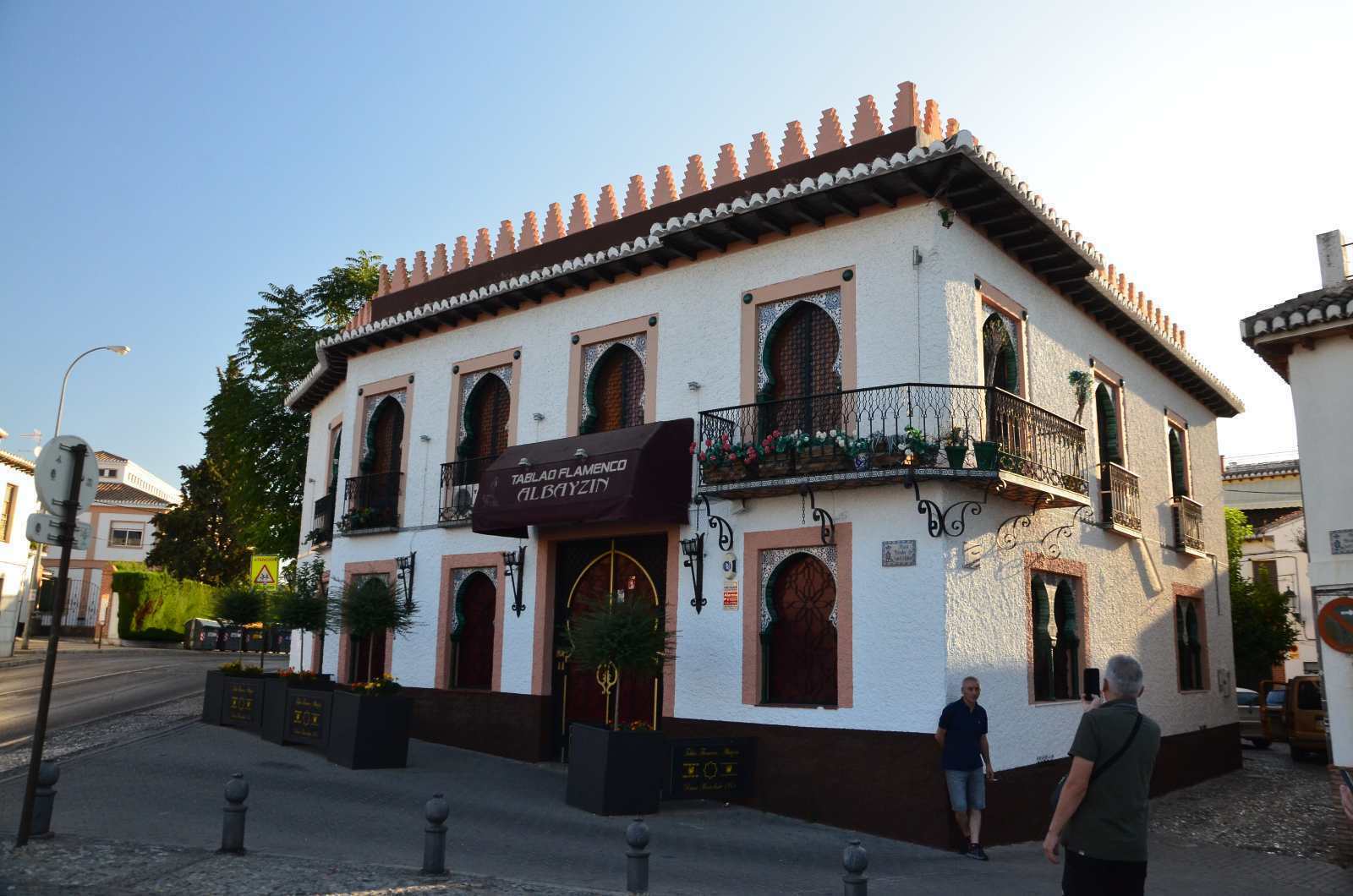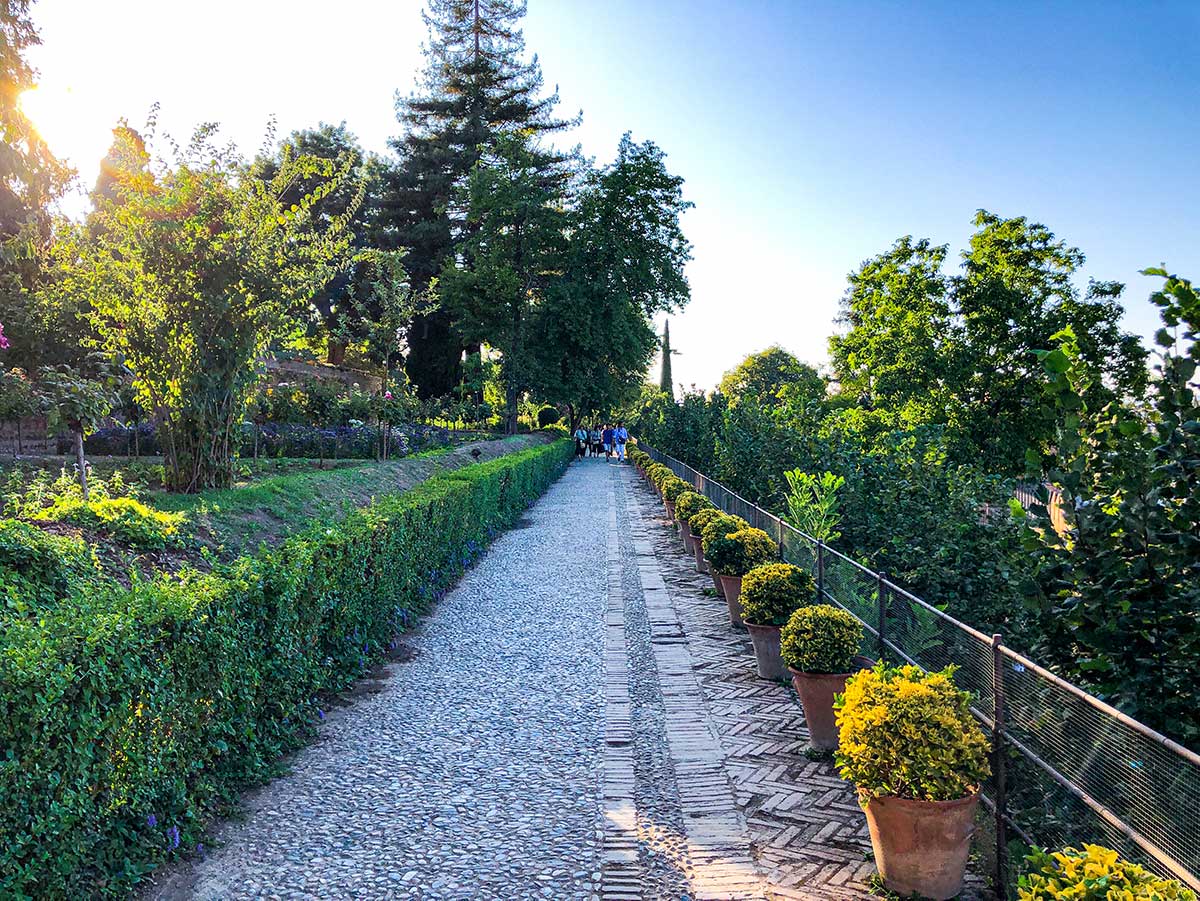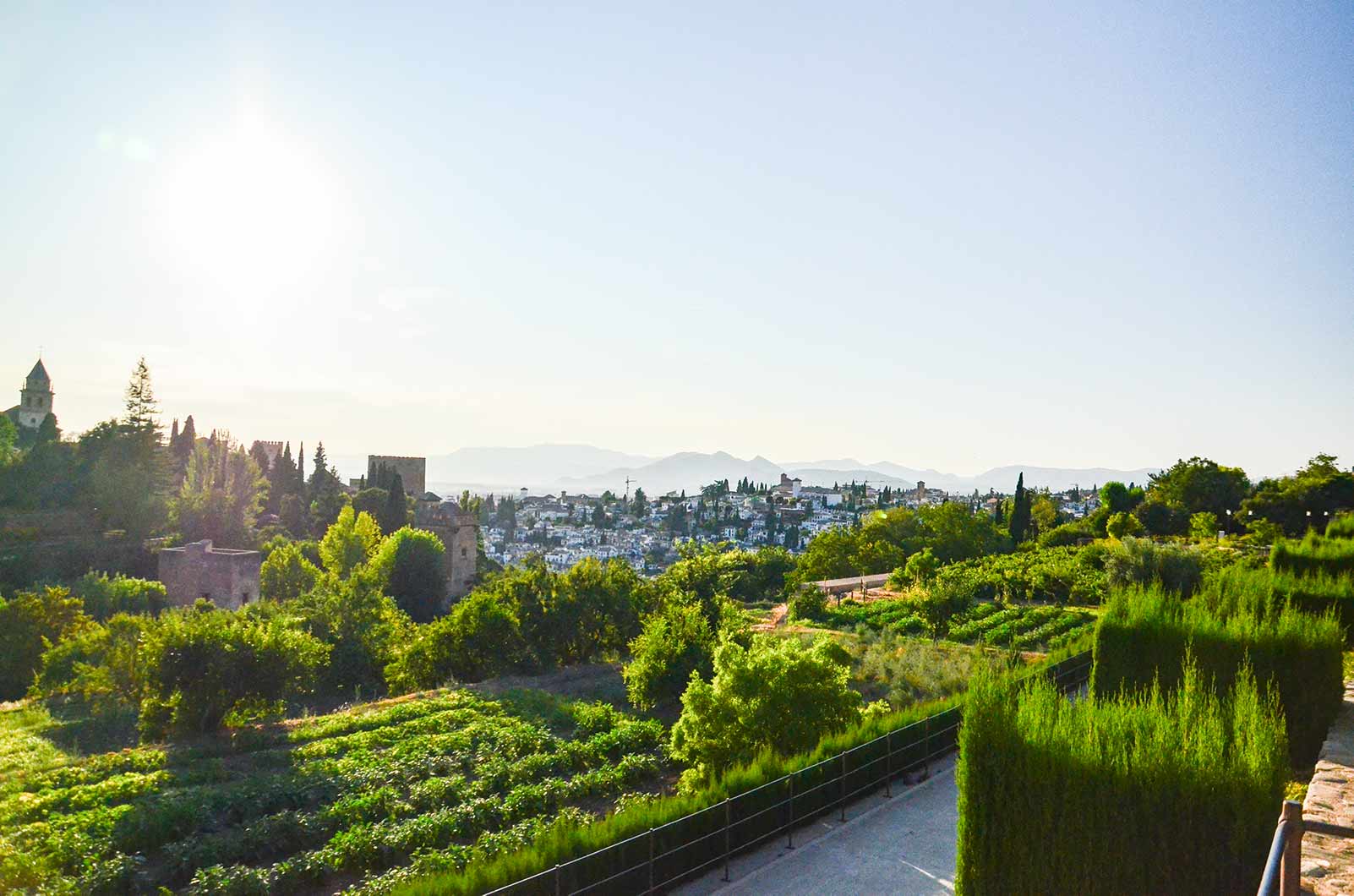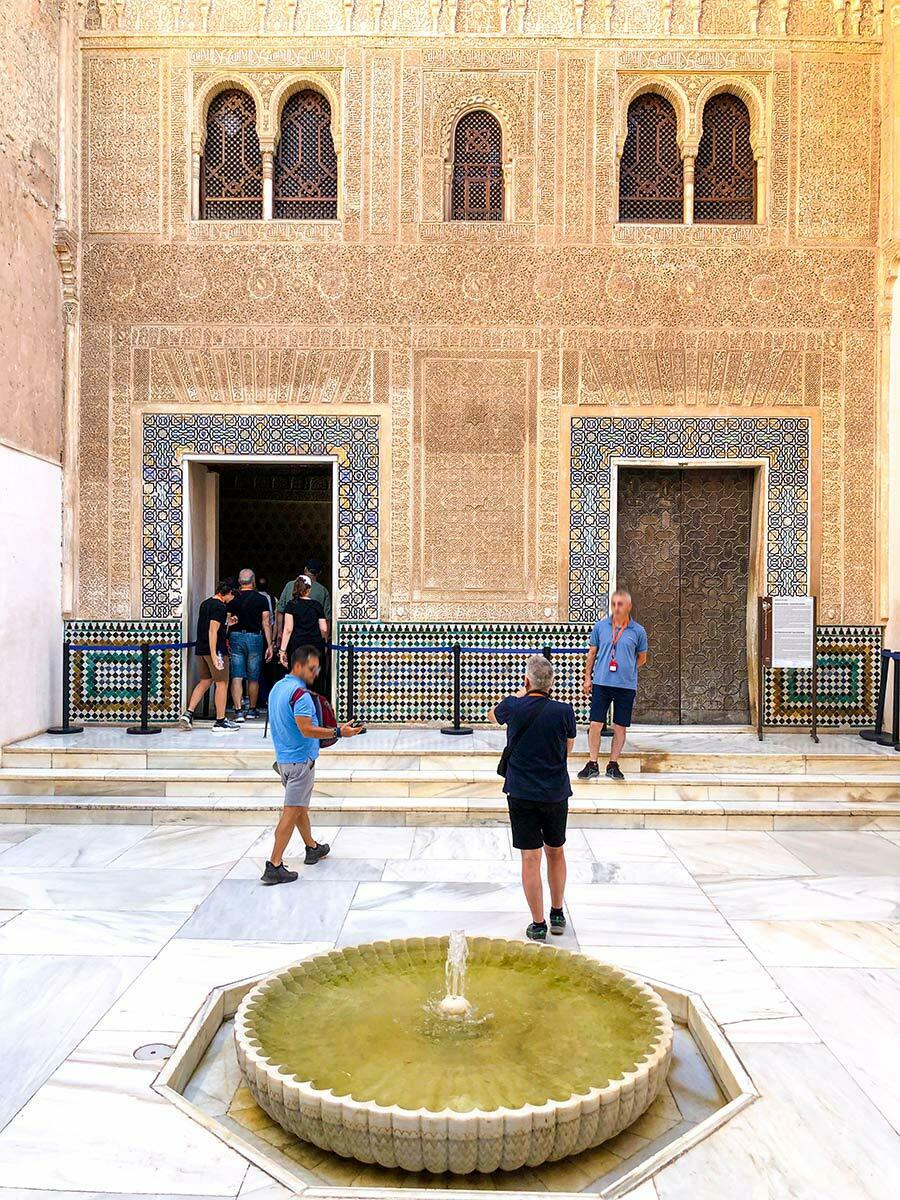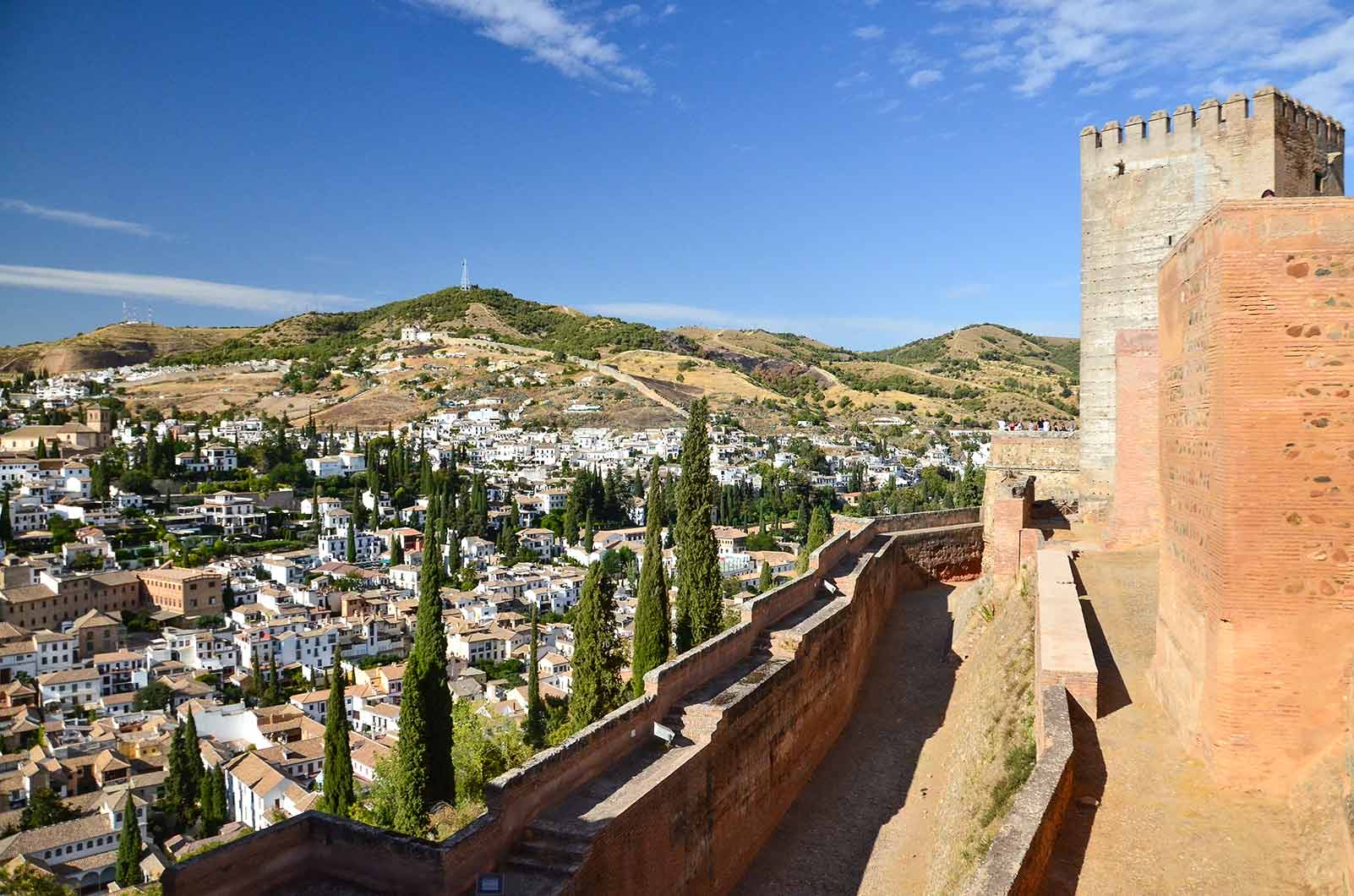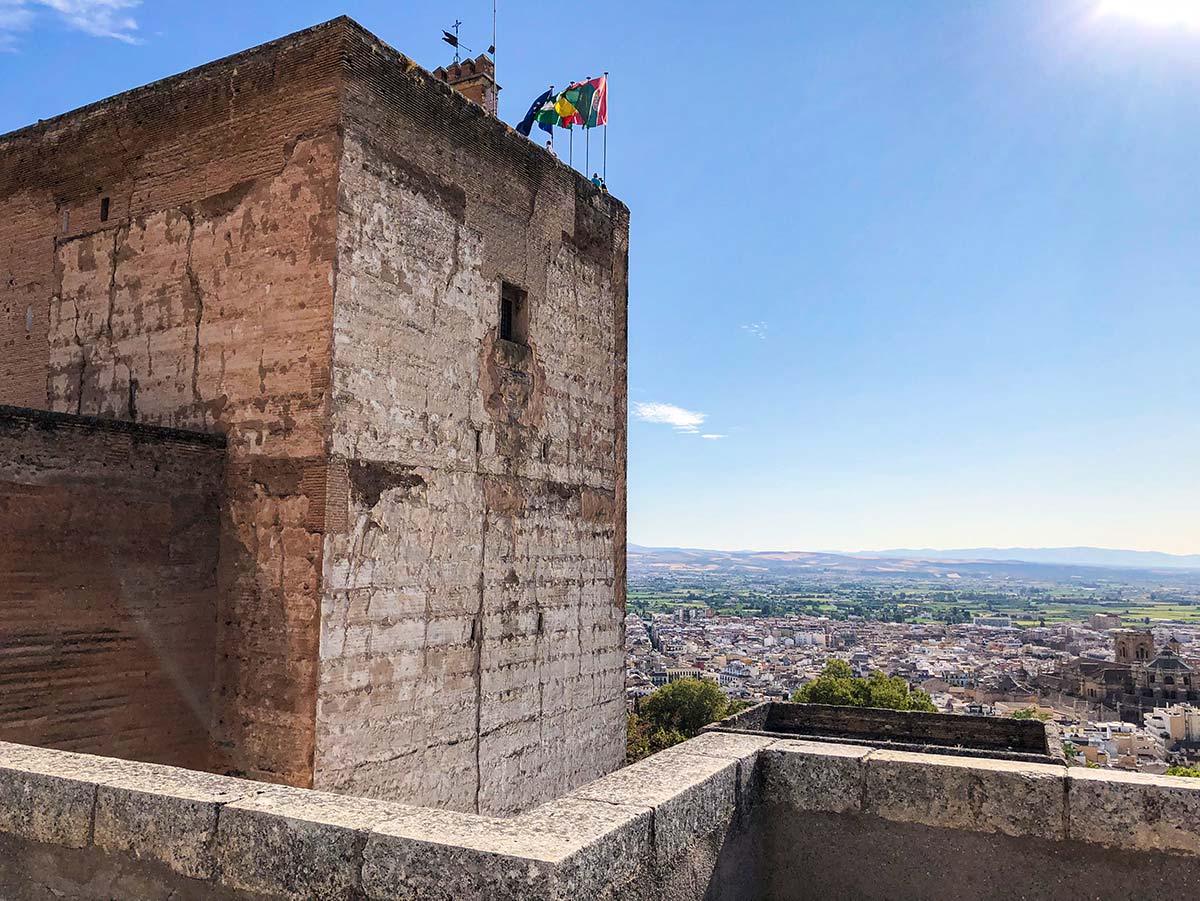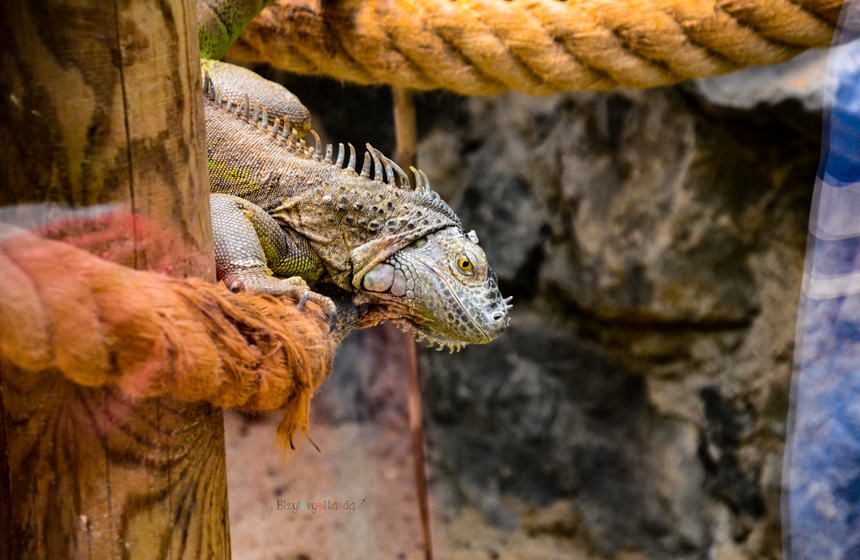Alhambra Palace
The Alhambra Palace, which is the masterpiece of Andalusian Civilization that gives life to water, and its story that will be the subject of a Thousand and One Nights tales. Parts of the Alhambra Palace to visit, its architecture, life stories, legends and historical change. Also, how can I easily buy tickets to the Alhambra Palace? We visited and saw the ticket tips, current ticket prices and what you need to know about the Alhambra and we prepared the Alhambra Palace Travel Guide for you.

Red Palace: Alhambra
The Alhambra Palace is located on the dominant hills of the city of Granada, located in the south of Spain. It was rebuilt on the historical city walls from the Roman period.
The historical castle, located within the borders of Spain‘s Andalusia (Andulusian) Region, did not undergo any repairs until the beginning of the 1200s. During the Andalusian period, the Alhambra Palace was transformed into its present form by the Emir of Granada (Granada), Muhammed Nasır. With the weakening of Andalusian domination, Roman and Byzantine architecture and additions were made to the palace.

The Alhambra, the last remaining land of the Andalusian State in Spain, is the most magnificent historical monument of the city of Granada and even of Spain.
While visiting the Alhambra Palace, I felt like I was in the Tales I read in my childhood. So much so that even its historical smell was still on it. Who knows what stories have lived through these stone walls for centuries.
History of the Alhambra Palace
With the conquest of Spain by the Muslim Andalusian State, a number of changes were made in its historical and architectural structure. The most obvious and most magnificent of these was undoubtedly the Alhambra Palace.
Alhambra Palace in World Languages
Turkish: El Hamra Sarayı
Spanish: Alhambra
Arapça: الْحَمْرَاء
English: Al Hamra
The palace and its associated works, which are like a summary of Andalusian Art History, attract tourists from all over the world every year. After the city of Granada remained in the Muslim Andalusian administration for a long time, political conflicts and wars broke out with the Castilian Christians. The fight for the throne between King Mohammed and his father was the spice of this process.
As a result, as a result of a bloody war, King Mohammed closed himself and his relatives in the Alhambra Palace. So much so that they continue their lives in the palace for months without the need for any source, including water. They even harvest crops from the gardens and fields in the Alhambra Palace.
However, the other Andalusian cities of Cordoba (Kurtuba) and Seville could no longer withstand the loss and increasing pressures. Just as Muhammad Nasser’s father predicted, the key to the city was handed over to the Queen of Spain, Isabel, in the Alhambra Palace, and the city fell.
We have given extensive information about the city of Granada, which includes the Alhambra, in our Granada article.
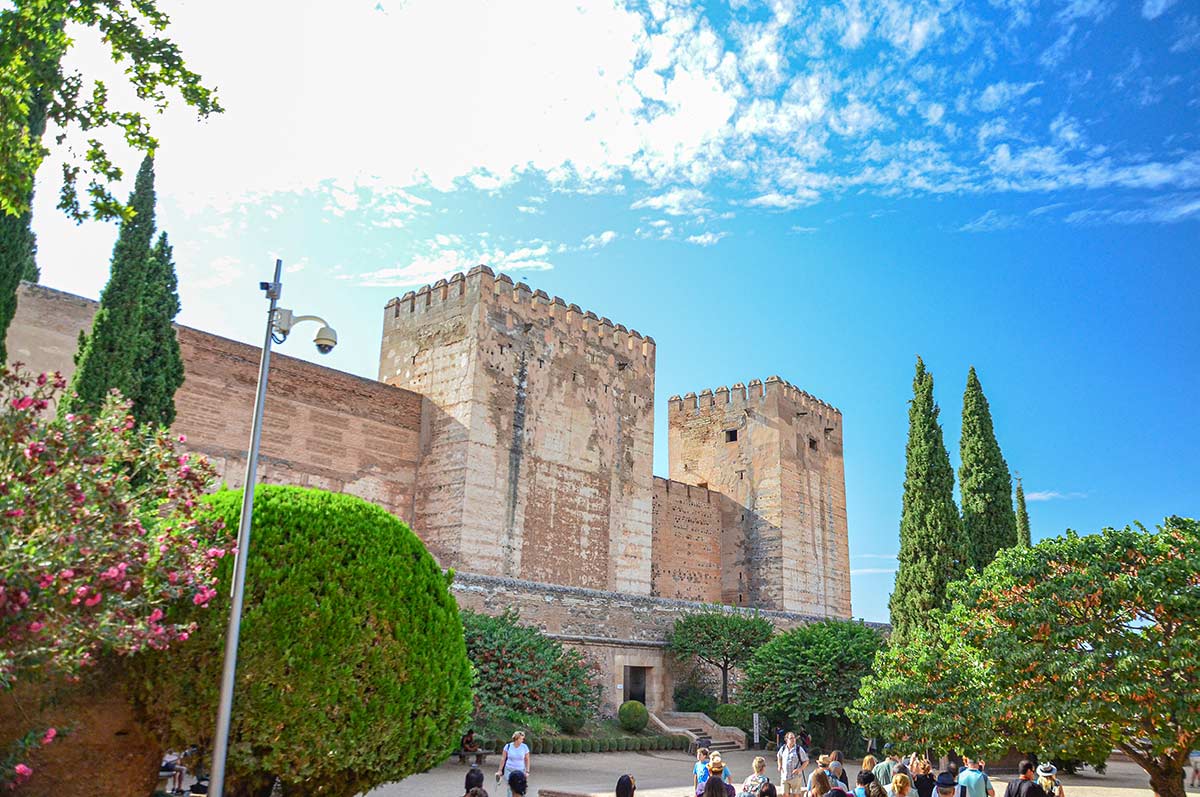
We can call the Andalusian state a water civilization. Because by taming and controlling the water, they managed to use it inside the buildings, just as it is today. So much so that even if you close the doors of the Alhambra Palace completely and cut off your contact with the outside world, you can live inside for years.
The Andalusians are the first civilizations in history to have discovered the “Water Wheel” and carried water to higher regions. It is possible to see today’s examples in the cities of Granada and Cordoba on the Taho river.
Some of the structures you can see in the Alhambra Palace are:
- Spacious Courtyards
- Large and small pools
- Fruit and citrus orchards
- Agricultural fields
- Fountains and waterways
- Hall and Rooms
- Cellars
- Balconies and terraces
- Arch, Intricate and Keyhole shaped doors.
Parts of the Alhambra Palace
The entrance to the castle is made through the walls, which have a very simple castle architecture. You can reach all parts of the palace by going up a narrow staircase that resembles a labyrinth and at the end.
In the palace, where there are many halls and rooms, the ceilings of some rooms are made of wooden beams. The ceilings of some rooms are adorned with intricate stone carvings.
- Generalife (Sultan’s Garden of Eden – Cennetul Arif)
- Nasri Palace
- Lion Courtyardve Fıskiye
- V.Carlos Palace
- Alcazaba (Elkasaba)
1. Generalife
It is the section used as the administrative office of the Emir of Granada, who ruled the Andalusian State. State rulers representing the Nasri Dynasty used this palace during the summer season. It was built by Muhammad the 3rd and later restored during the reign of Ismail the 1st.
A very cool environment has been created with the waterway, pool and fountains accompanied by flowers and green plants. The garden right in front of it is the most famous Persian style garden that has been preserved until today. In addition, the reputation of this garden has been registered by UNESCO.
Generalife, which underwent another restoration in the recent past, that is, at the beginning of the 20th century, regained its current form. Leaving the Andalusian architectural style, some changes in Spanish architecture are striking at first glance.
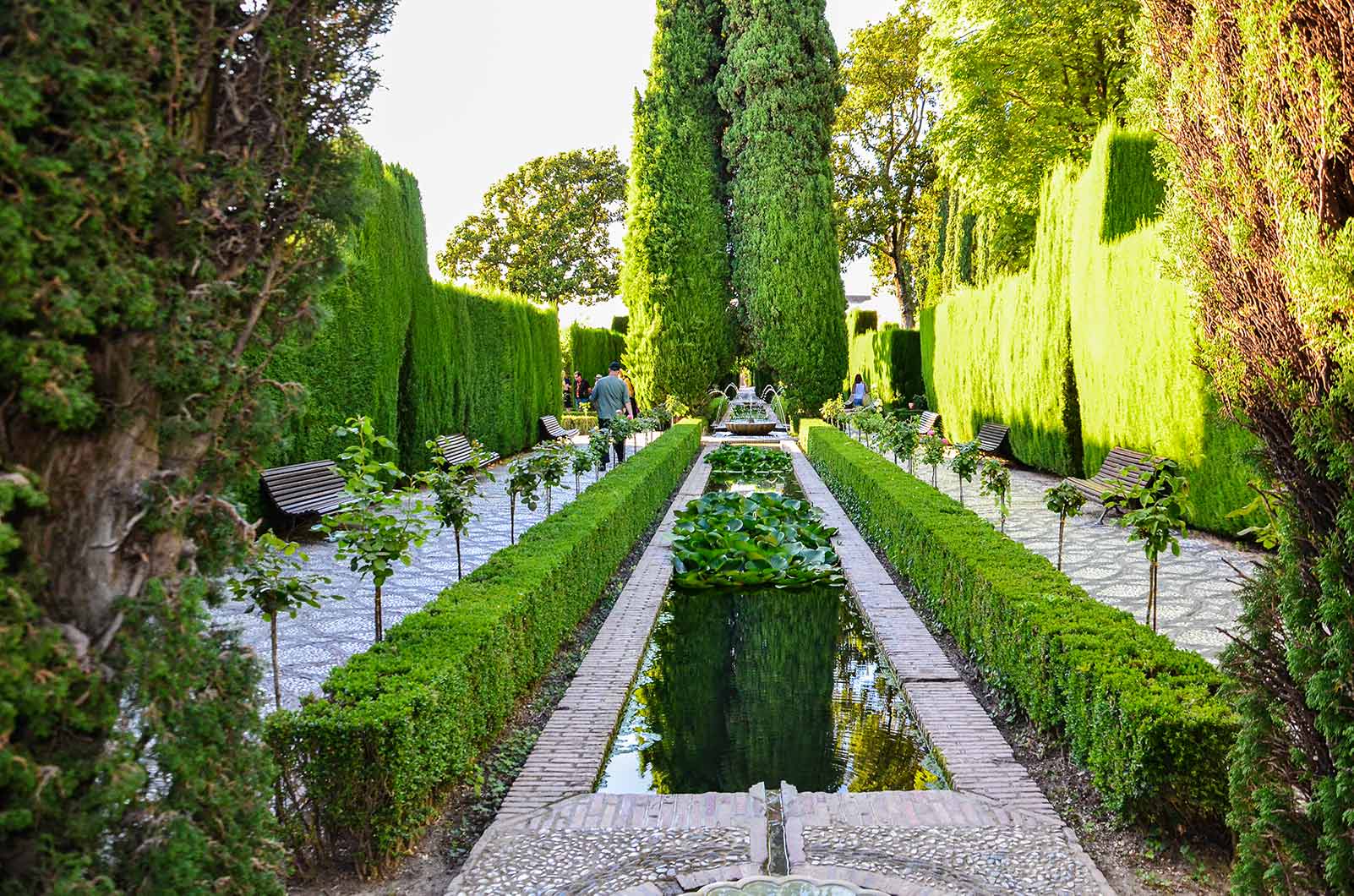
The original name of the part known as Generalife in Spanish and English is known as “Cennet-ul Arif“. It is the part that the Emir of Granada uses for rest when he comes to the Alhambra Palace to work in the summer.
It is home to two important sections, the waterway and the Emir’s Garden. You must see these episodes. The 8-century old Cypress tree in the garden is also worth seeing. This part, called the Sultan’s Gardens of Eden, will take your heat and tiredness like a mirage in the middle of the desert.
While visiting the section in the photo above, namely Cennetul Arif Gardens (Generalife), I came across a tiny snake. I panicked a bit. However, the officials said that this is quite normal and that there are many snakes, but most of them are non-venomous and harmless.
Heaven-ul Arif, the Garden of Eden, with its unique simple design and adorned with flowers and insects, will never leave your mind.
2. Nasri Palace
Among the parts of the Alhambra palace, it is the part that stands out with its architecture and splendor. Before visiting the Alhambra Palace, do not forget to include the “Nasri Palace” (Palais Nasrides) section when you buy a ticket. In almost all sections, you have to scan the barcode on your ticket during the transitions to each other.
Nasri Palace, which was built during the reign of the prince Muhammad V, who took over the Sultanate from Yusuf I, has a dazzling architecture with both its interior and exterior appearance. It is a must-see part of the Alhambra Palace.

In the period when it was built, those who wanted to meet with the Sultan and the state officials gathered and made a request. This section is reached by passing through the corridor called Masvar. Wall and ceiling decorations fascinate those who see them.
When you look carefully at the ceiling of the hall of the ambassadors palace, you will see the masterpiece of sky, stars and planets. It was unearthed with a kind of craftsmanship that we can definitely call the turning point of woodworking. This architecture, which is used in ceiling work, is one of the most important examples of the “Muqarnas Art“, which is a wooden art.
You will see the inscription “La Galibe İllallah”, which is almost in the entire Alhambra Palace, on all the wall and ceiling decorations of the Nasser Palace. Although most of the room bears the traces of the Andalusian period, you can also see the dominant lines of the Christian period.
When you pass through the arched door on the left in the courtyard (the door on the left in the upper picture), you pass to the section specially built for Yusuf I. The Spanish name of this section belonging to Sultan Yusuf, designed by the architects and engineers of the period, is Comares Palace.
3. Lion Fountain and Courtyard
When you pass through the side gate of the Nasri Palace, you will see the lion-figure pool and fountain made of stone columns. Aslanlı Courtyard is one of the places where visitors spend the most time.
Here, you will witness how the Andalusians, an Islamic state, can use engineering and geometry. With their unique engineering methods, they used streams, rivers and other natural water sources, which are very low in altitude, and successfully carried the water to high points.

Another civilization that steers the water with its engineering intelligence in the European continent is the Dutch. In other words, the story of the construction of the Netherlands today is almost similar to the Andalusian. They disciplined swamps, reeds and ponds like Amsterdam with the windmills they built, and eventually they created land behind by directing the water.
The fountain and the mini bird pool, located on 12 lion figures made of chipped stone, are like a masterpiece of the Andalusian Water Civilization. The waters flowing down from the mouths of the lions are distributed all over the courtyard with 4 different water channels. Thus, the hot and dry air of Southern Spain suddenly turns into a cool and quite spacious area. You can still feel this feeling while walking around the Lion Courtyard.
You should definitely visit the Nasri Palace, which takes its visitors back hundreds of years and takes them on a journey in history. When purchasing tickets for the Alhambra Palace, be sure to select the Nasri Palaces section. You will not regret.
4. V-Carlos’ Palace
While visiting parts of the Alhambra Palace, you will definitely see the Carlos Palace, which does not match with its nature, architecture or historical texture. The interior of the Carlos Palace, which you see angular when you look from the outside, has a circular architecture like an arena.
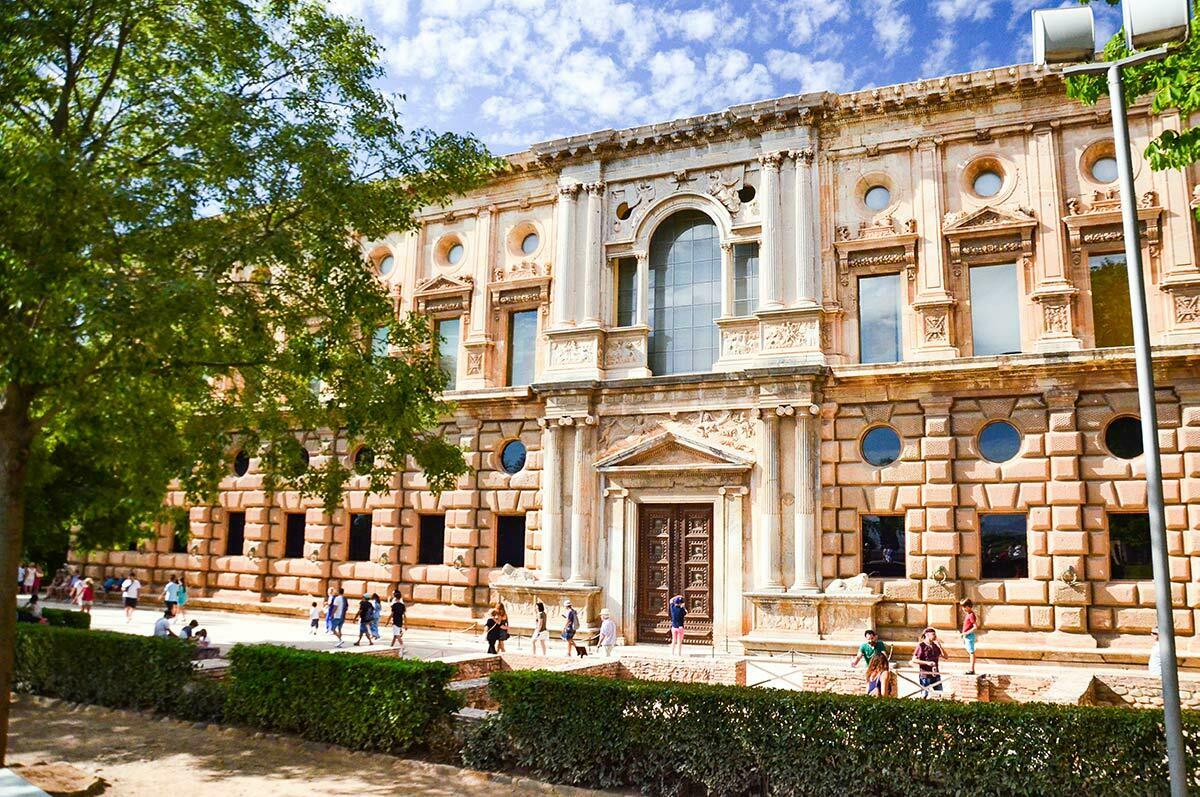
Born in Belgium and raised in the Netherlands, Charles V also carried both German and Spanish genes. For this reason, he became an important emperor for the Christian world. I found the exemplary letter he wrote to the famous Ottoman Sultan Suleiman the Magnificent, on Wikipedia.
All this time, you’ve been trying to be a erlik, you say you’re a stair square. How many times have I come upon it and dispose of its property as I wish.
Neither you nor your wife have a name or an engagement. The cause of sultanate and masculinity is haram for you. Wouldn’t you be ashamed of your soldiers, maybe even your man, that maybe there is effort in the aura and you don’t have it. If you are male, let it happen. Whatever the judgment of Allah Almighty is, it will be.
Let’s meet you at the gates of the reign of Bec (Vienna). May even the poor of Reaya be calm. Otherwise, as you find the square empty of lions, don’t count hunting with opportunity like a fox. If you do not appear this time, you should not try to take the crown of the sultan by buying wool and spinning wheels like women. Don’t let the name Erlik speak your language.
Source: https://tr.wikipedia.org/wiki/V.Karl
This section, which was built during the reign of Karl the fifth, whose Spanish name is Carlos, has an architectural appearance that is quite far from Andalusian Architecture. King Carlos, called Charles V by the French, served as the Kingdom of Spain and also the Roman Empire in the 16th century.
Impressed by the Alhambra Palace, V-Carlos orders the architects and artisans under his command to design a much more beautiful and magnificent work than the Alhambra. Even though it has a very ambitious architecture when considered on its own, it cannot even be read next to the Alhambra Palace.
It is known that a part of the Alhambra Palace was destroyed and destroyed while Carlos’ palace was being built. It is possible to say that Carlos’ palace was built in this area, but it went down in history as a dim work in the light of the Alhambra.
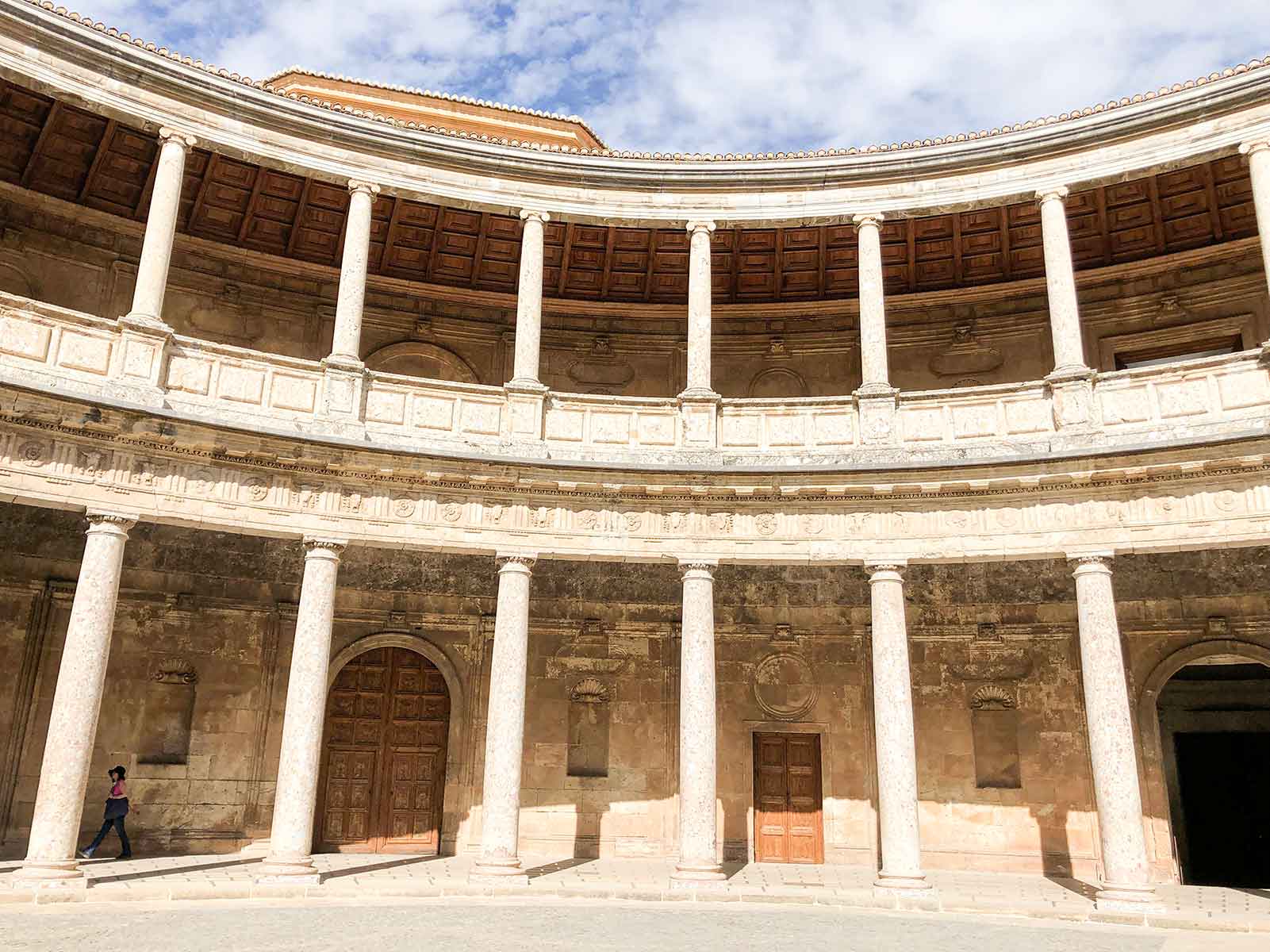
No matter how hard Carlos pushes his architects, a work emerges that can’t even compete with the Alhambra Palace. While the work is a great Spanish masterpiece on its own, it is rather dull and unattractive next to the Alhambra Palace.
5. Alcazaba (El Kasaba)
When you enter the Alhambra Palace through the walls outside, labyrinth-like walls surround you. When you go up the stone stairs, you reach the section called Alcazaba, which resembles a castle.
This is the section where the internal security and defense affairs of the palace are carried out. It was designed as a castle surrounded by walls. In this way, it provided an effective protection against attacks that may come from outside at that time. At the same time, you can see the cellars (prison) descended from the spiral stairs in the Alcazaba section.

Passing through the tired walls that witnessed dozens of wars, you reach the outer part of the Castle and the Walls. That’s why the Alcazaba is in a great location from which you can have a panoramic view of the city of Granada. The Alcazaba’s dominant position has also caused it to be called the “Granada Watchtower”.
However, since this section is mostly made of stone and brick materials, the temperature is quite high. Even today, you can drink as much water as you want from the fountains flowing in this section.
The hand figure named “Fatma’s Hand“, which is the most curious of the guests who come to visit the Alhambra Palace, is also in the Alcazaba section. The Alcazaba is entered through two doors. On one of these doors, there is the figure of Fatma’s Hand, while on the other door, the Word-i Shahada is written in its original Arabic form.
The Inscription “La Galibe İllallah” Found in the Alhambra Palace and Its Meaning
Queen Isabella received the Alhambra Palace from King Mohammed without shedding any blood. As soon as the palace is captured, the city of Granada falls and the Queen does not keep her promise. It forces people of all ethnic and religious beliefs to become Christians, except the Christian population. He says either become a Christian or leave this land.
The people consisting of Muslims, Jews and Gypsies (Chips) are forced to migrate. Those who do not want to go are executed by the guillotines set up in the Medina square. According to rumors, many Jews and Muslims lost their lives here.
However, according to some historians, the Queen did not remove any of the verses “La Galibe Illallah” (The only victor is Allah) written on the walls and ceilings in order not to spoil the architectural texture of the palace, according to others. Neither Queen Isabella nor the later Spanish rulers did not remove this verse and caused it to reach the present day.

Alhambra Palace Entrance Ticket
You need an entrance ticket to visit the Alhambra Palace in Granada, Spain. You can buy this ticket at the box office or online. However, you may not be able to find tickets in the summer season as the number of visitors is limited for some sections.
How to Buy Alhambra Palace Ticket?
That’s why before you go to Spain, you should buy tickets online to visit all parts of the Alhambra without any problems. If you’re going with a tour package like me, tour operators usually do this for you and you won’t have any problems.
You can buy tickets for a future date at https://tickets.alhambra-patronato.es/, the official ticket sales site for the Alhambra Palace. There is a precaution they take to prevent black market tickets. You need to be extremely careful with this. For Spanish citizens, you are asked to enter your Identity ID number and for foreign citizens, you are required to enter the Passport serial number without error.
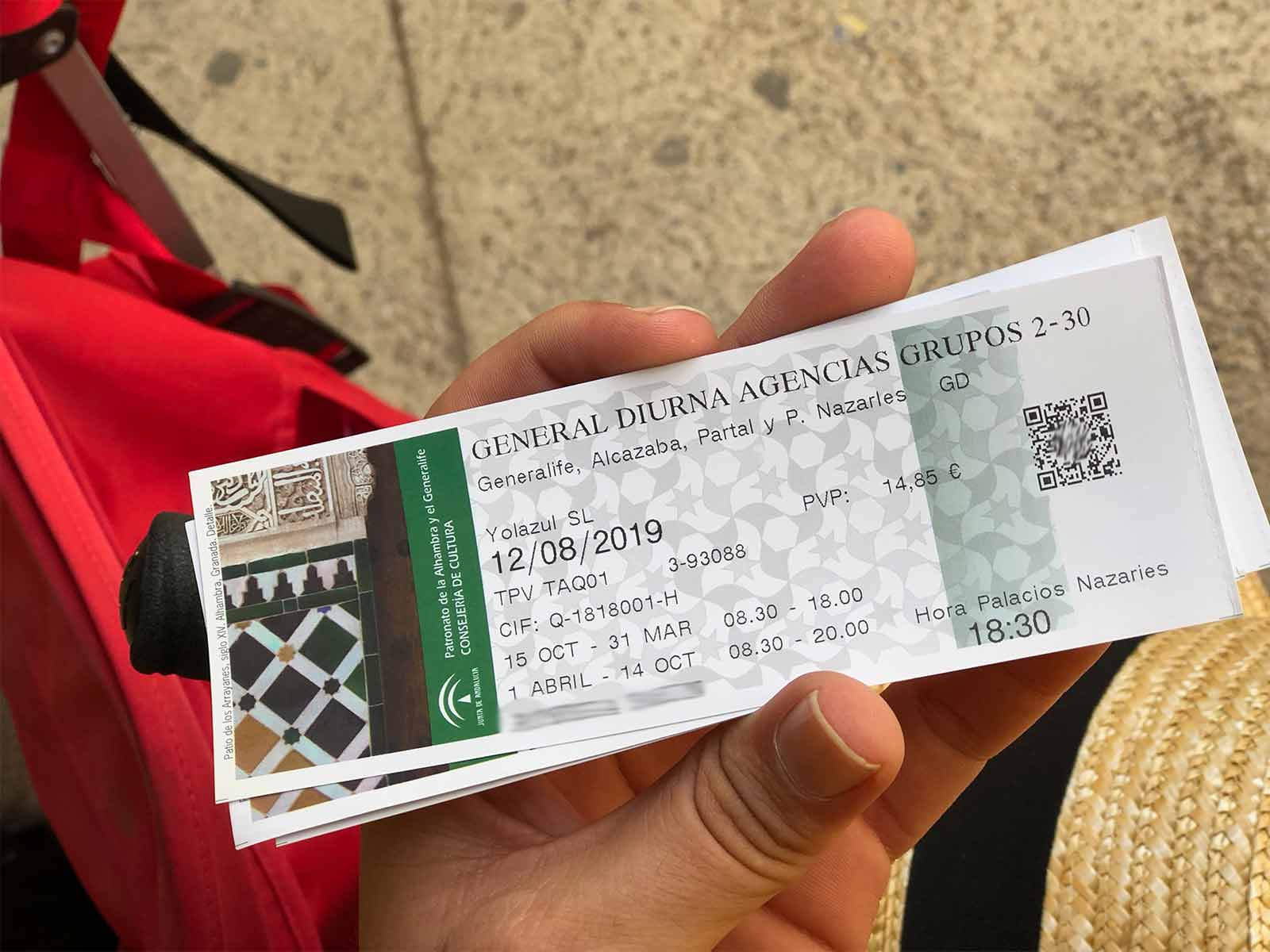
If you are traveling as a group and the total number of people is more than 20, you must also purchase a Spanish guide service. There is no such requirement for groups not exceeding 20 people.
Alhambra Palace Ticket Fees
When you come here to visit the Red Palace, ticket prices may vary according to the departments. The current price list of Alhambra Palace entrance tickets is as follows.
| Parts | Price |
|---|---|
| Alhambra Palace All Sections | 14.00 € |
| Gardens, Generalife and Alcazaba | 7.00 € |
| Dobla de Oro General (Alhambra + Andalusian Monuments) (Albaicin) | 19.65 € |
| Nasri Palace Tour (Night) | 8.00 € |
| Gardens and Generalife (Night) | 5.00 € |
| Dobla de Oro General (Alhambra + Andalusian Monuments) (Albaicin) (Night) | 14.65 € |
| Alhambra Experience | 14.00 € |
| Alhambra Palace and Rodriguez Acosta Foundation Combined Tour | 17.00 € |
| Albaicin (Andalusian Monuments) | 5.00 € |
There is no discount ticket application for visiting the Alhambra Palace. Children are also charged at these prices. You can buy entrance tickets to the Alhambra Palace by using the online ticket system or ticket offices.
We searched and visited the most frequently asked questions and information from the visitors and prepared this short information sharing for you.
Which state does the Alhambra Palace belong to?
Today, the Alhambra Palace is within the borders of Spain or officially the Kingdom of Spain.
Where is the Alhambra Palace? In which city is it?
It is located in the city of Granada, within the borders of the Spanish province of Andulusia (Andalusia).
When was the Alhambra Palace built?
It was built by the Islamic State of Andalusia in the early 13th century in the city of Granada (Granada), on the walls of a ruined fortress from the former Roman Empire. Over the years, it has managed to reach the present day by making additions and renovations by different emperors and states.
Who built the Alhambra Palace?
It was built by Muhammed Nasır from Granada in the early 1200s during the Andalusian period. However, many parts of the Alhambra Palace today were built in later periods and added to the palace.
Where is La Galibe illallah inscription located in the Alhambra Palace? What does it mean?
You can see this verse almost everywhere, except for the Carlos Palace section of the Alhambra palace. You can see it embroidered on walls, ceiling decorations, reliefs and tiles. So much so that although Christian states have ruled from Andalusia to the present day, they have not touched any of these verses.

